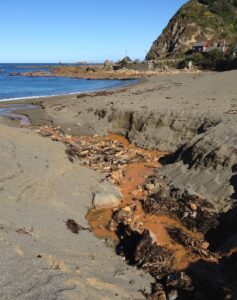
One of Wellington’s earliest landfills, the Houghton Valley design was pretty primitive by today’s standards, with no lining, and covered with varied and sometimes minimal capping that wasn’t particularly waterproof. The pipe network under the rubbish was designed to capture the original creek water, water from the freshwater springs, overland water from the hillsides and stormwater from the roads (and hence the houses, which disperse their water directly onto the street).
Whether the pipes were meant to capture leachate or not, the water that seeps into the fill area and collects heavy metals and a large quantity of iron, also ends up in the pipes. During low flow, the water in the pipes is diverted to the sewer, but 30 mm of rain will cause the flow to overtop the jumping weir system and it is directed into the sea at Houghton Bay, now part of the Tapu Te Ranga Marine Reserve.
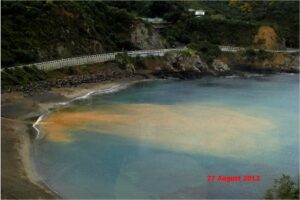
As well as visibly contaminated water flowing from the outlet at Houghton Bay beach at times, great plumes of water can be seen usually just after the rain begins after a settled dry spell. The timing of these plumes is a bit of a mystery – there is usually not enough water to overtop the weir. A possible explanation is that extra water from the Cave Rd spring and stormwater drains below the weir sends down enough water to stir up the sediment in Houghton Bay and discolour the water. Needless to say, surfers in Houghton Bay have reported rashes after swimming there.
A programme implemented by Capacity (now Wellington Water) involves a 6-monthly flushing of the pipe network to remove encrustations. This doesn’t seem to have solved the problem.
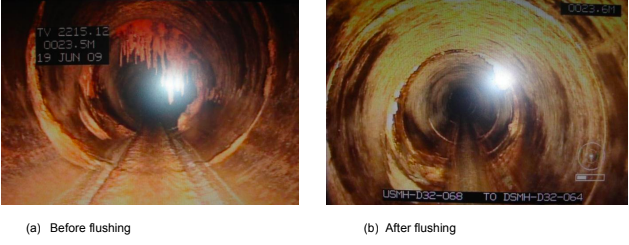
Making a noise
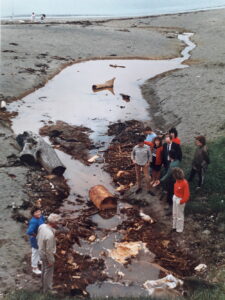
In a newly surfaced box of archive material we found a picture of residents showing Councillor John Gilberthorpe the leachate problem back in 1989. Accompanying correspondence indicates that residents have been trying to get the issue fixed since the early 1970s. Back in February 1978, the Houghton Valley Progressive Association minutes recorded that the Parks and Reserves Department be asked to bulldoze the beach to clear the outfall of leachate from the tip. A long time resident also commented that at one stage they had to dig a channel from a naturally formed lagoon that was badly contaminated. It seems that a proper solution has always been deemed too expensive. The situation has been improved over the years, but then standards have gone up at the same time. The problem isn’t fixed yet. Below is a sample of more recent protests about the leachate.
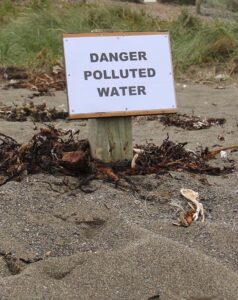 John of Island Bay often walked along the South Coast towards Houghton Bay and was very vocal about any leachate that he saw. He said:
John of Island Bay often walked along the South Coast towards Houghton Bay and was very vocal about any leachate that he saw. He said:
“My own active interest in the continuing intermittent flow of noxious leachate across the swimming beach at Houghton Bay, within the Taputeranga Marine Reserve began with an email to the WCC Mayor a year ago, on August 17, 2012, when there was a particularly foul discharge.”
He was very frustrated by the lack of response or action by the Council and took the story to The Dominion Post. John inspired locals to make more of a fuss, and to put up a sign by the outfall warning people of the polluted water, as he often saw children playing near it. In the meantime he put up a small laminated sign saying, “Danger Polluted Water”, which Capacity promptly removed. Read the full story here.
In February 2013, a group of locals arranged to meet with the City Council to present the issue of leachate going onto the beach from the old landfill and what to do about it. Although not much really eventuated from the meeting, one of the locals provided some very graphic photos, which are now featured under Leachate on this website.
More recent local protests:
- Still Making Wellington Beach Reek of Petrol 3 January, 2020
- Rank Brown Plume Emerges at Houghton Bay 19 August, 2020
- Toxic Sludge Spews onto Houghton Bay Beach 19 November, 2020
- This Beach is Toxic February 22, 2023
There may well have been more, but you probably get the picture!
Hydrocarbon Odours
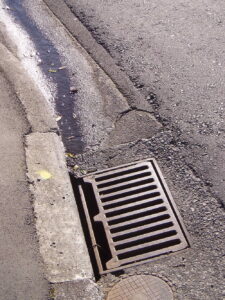
Another consequence of the leachate and/or organic material getting trapped in the system and rotting is the formation of hydrocarbon odours. These not only come out at the beach, but emanate from the stormwater drains around the valley and enter into residents’ homes, making life very unpleasant at times. The worst odours seem to be in the vicinity of Hungerford Rd. Separating the stormwater from the leachate pipe would solve this issue.